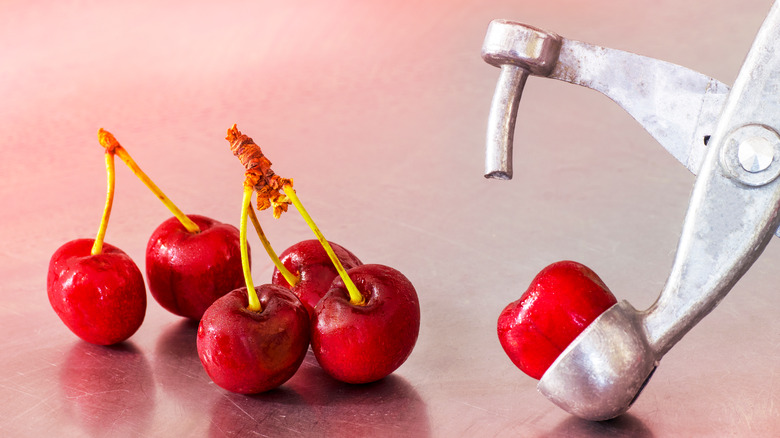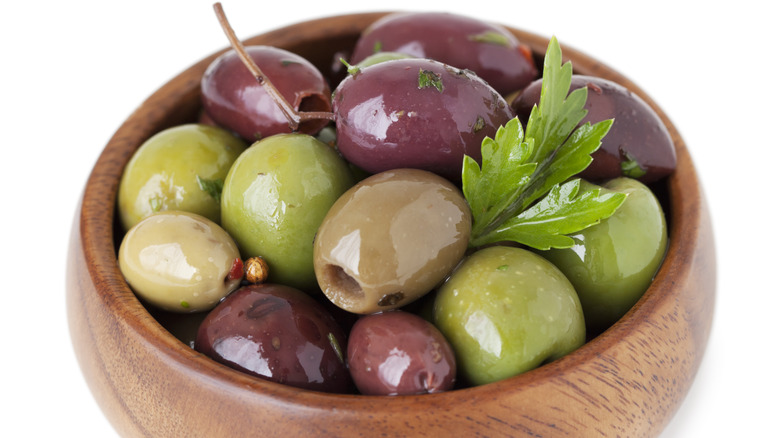Why You Shouldn't Buy Pre-Pitted Olives, According To Ina Garten
Salty, tangy olives have built quite a reputation as a kitchen shortcut. They elevate cocktails, enrich braises, and satiate hungry dinner guests. But, they do have one glaring, well, pitfall.
Nothing ruins a meal or a party faster than a rogue olive pit, which is not only unappetizing but can chip and crack teeth. Yet, while pre-pitted olives seem like a viable solution and are a helpful hack for busy households, they come with tradeoffs in quality. Removing the centers allows brine to permeate the inner flesh, rather than just the fruit's exterior. This makes them saltier and can cause the firm texture to soften as they sit in the jar.
Cookbook author and hostess extraordinaire Ina Garten has a solution, however. She skips pre-pitted olives, and instead opts to buy them whole. In her "Cook Like A Pro" cookbook, Garten explains that she simply uses a cherry pitter to pop out the offending seeds. The simple technique allows her more control over the ingredient while also retaining quality in olives' flavor and texture.
How to use a cherry pitter
To follow the Barefoot Contessa's lead with this trusted cherry pitter hack, you'll of course want to start by purchasing her trusted tool. Individual cherry pitters cost about $15, while larger pitters capable of tackling six cherries or olives at once run closer to $22. Both options are fairly intuitive and, after putting the olive in the center and applying pressure, they push out pits using a thin prong.
You could also skip the gadgets and remove the centers the old-fashioned way: by hand. If you choose to forgo the equipment, try using the flat of a chef's knife or a meat pounder to gently smash the olives. This will loosen the stones, allowing you to pry them out with your fingers or a paring knife.
If the olives prove too tough to pit yourself, leave them whole and pivot your presentation. Ina Garten often serves green and black varieties warmed with aromatics including red pepper flakes, fennel seeds, orange zest, and garlic. You could also pair them with another of Garten's favorite almonds, Marcona style, or whip up a copycat of the luxurious cocktail snack.
Ina Garten puts pitted olives to use
Of course, removing the stone in olives takes elbow grease, and may result in some wonky shapes and smashed specimens. Though some would argue imperfection is part of the charm, if your recipe requires uniformity, you of course could always skip the DIY approach and buy pre-pitted olives in a pinch. Same goes for large-scale recipes or if you're in a time crunch. Though not ideal, as the pro herself would say, store-bought is fine.
Regardless of how you get there, once you have a pile of the salty snacks, you're ready to put them to good use. Ina Garten puts the ingredient to work in chicken marbella, where she amplifies olives' briny bite by pairing them with capers, sweet prunes, and a heap of minced garlic. She makes up for lost pitting time with her lightning-fast method for peeling a lot of garlic: blanching whole cloves in boiling water.
Garten's insistence on high-quality ingredients also shines through in her elegant tapenade recipe, which calls for a half-pound of Kalamata olives. She blitzes the fruit with acid, herbs, and anchovy fillets to create a punchy toast topping. The dark-hued globes are the star of the dish, making your pitting efforts all the more worthwhile.



